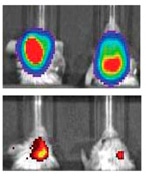Apr 12 2017
 The top row indicates mice with glioblastoma controlled for tumor size. The bottom row shows their expression of MGMT, a protein that makes tumor cells more resistant to chemotherapy. The left is a control, while the right shows significantly decreased levels of MGMT after treatment with the nanoparticles. Credit: Northwestern University Feinberg School of Medicine
The top row indicates mice with glioblastoma controlled for tumor size. The bottom row shows their expression of MGMT, a protein that makes tumor cells more resistant to chemotherapy. The left is a control, while the right shows significantly decreased levels of MGMT after treatment with the nanoparticles. Credit: Northwestern University Feinberg School of Medicine
An innovative testing platform for the real-time assessment of effectiveness of nanomaterials in gene expression regulation has been developed by researchers at Northwestern Medicine. The outcomes of the research have been reported in Proceedings of the National Academy of Sciences and can assist in preclinical investigations and can optimize nanotherapeutics for cancers even before the clinical trial stage.
The research investigates the application of the platform in animal models. The first author of the study is Timothy Sita, a seventh-year MD/PhD student at the Medical Scientist Training Program.
This is an important step forward for the field. The very thorough optimization that we see in conventional drug development had been missing in the nanotech space, and we felt very strongly about changing this. The system that we developed here really allows us to support those efforts, and evaluate our nanoparticles in the most relevant models, in an in vivo setting.
Alexander Stegh PhD., Assistant Professor of Neurology and of Medicine, Northwest Medicine
The other corresponding author of the paper was Chad Mirkin, PhD, the George B. Rathmann Professor of Chemistry in the Weinberg College of Arts and Sciences and a professor of Medicine in the Division of Hematology/Oncology.
In order to demonstrate their research, the researchers targeted a resistance factor gene in glioblastoma (an incurable, aggressive kind of brain tumor) by using nanostructures known as spherical nucleic acids (SNAs).
Initially created in the year 1996 by Mirkin at Northwestern, SNA are formed of dense strands of RNA arranged around a nanoparticle core. The distinctive properties of the SNA enable them not only to cross the blood-brain barrier but also to enter into tumor cells, thus directly targeting gene activity promoting the growth of cancer.
Although these conjugates seem to be a favorable tool in the age of precision medicine, what was lacking was a quantitative technique for assessing the way in which the SNA regulated gene activity in living organisms—which can lead to the optimization of the therapies .“We’ve seen that these particles can basically target any cancer gene, but we didn’t know when they worked best or what dosing regimens to use,” stated Sita. “As such, preclinical trials weren’t as successful as they could have been.”
The researchers involved in this demonstrated that a specific kind of non-invasive imaging can be used on the mice to perform real-time assessment of the way in which the nanoparticles had an impact on the levels of an intratumoral target protein.
Now we can tweak these particles — play with the shape of the nanoparticle, or how much RNA we load onto the particle, for example — and then assess very quickly whether those changes are more effective or not. It’s a platform to help optimize the drugs in mice before they go to human trials, and make something that will translate better to the clinic.
Timothy Sita, MD/PhD student, Medical Scientist Training Program, Northwest Medicine
Although the technique can be generalized for assessing nanotherapeutics for various kinds of cancers, the study also has significant clinical implications specifically for glioblastoma.
The researchers created nanoparticles for destroying O6-methylguanine-DNA methyltransferase (MGMT) in mice that have glioblastoma. MGMT is a protein that minimizes the effect of chemotherapy. They used the imaging platform and found out that levels of the protein in the mice was the lowest from 24 to 48 hours after administration of the nanoparticles, indicating the optimal time for chemotherapy delivery.
We showed a very significant reduction in tumor volume when we combined these particles with the chemotherapy. By silencing this gene that’s causing resistance to the chemotherapy, we can have a much more profound response. That’s the key clinical angle.
Timothy Sita, MD/PhD student, Medical Scientist Training Program, Northwest Medicine
Sita will be graduating in May and has joined a radiation oncology residency at the McGaw Medical Center of Northwestern University in the recent past. There he hopes to continue his glioblastoma therapy research.
The co-authors of the paper include Jasmine May, a fifth-year student in the Medical Scientist Training Program; Charles David James, PhD, professor of Neurological Surgery and of Biochemistry and Molecular Genetics; and other Northwestern researchers.
Mirkin, Stegh, and James are members of the Robert H. Lurie Comprehensive Cancer Center of Northwestern University as well.
The study was supported by the Center for Cancer Nanotechnology Excellence initiative of the National Institutes of Health (NIH) Award U54 CA151880, National Institute of Arthritis and Musculoskeletal and Skin Diseases Award R01AR060810, Defense Advanced Research Projects Agency Grant HR0011-13-2-0018, the John McNicholas Foundation and the American Cancer Society, National Cancer Institute (NCI)/NIH National Research Service Award Fellowship F30CA174058-01, a Ryan Fellowship, a National Science Foundation graduate research fellowship and a P.E.O. scholar award, the Northwestern University Flow Cytometry Facility, Northwestern University Center for Advanced Microscopy, and Cancer Center Support Grant NCI CA060553.